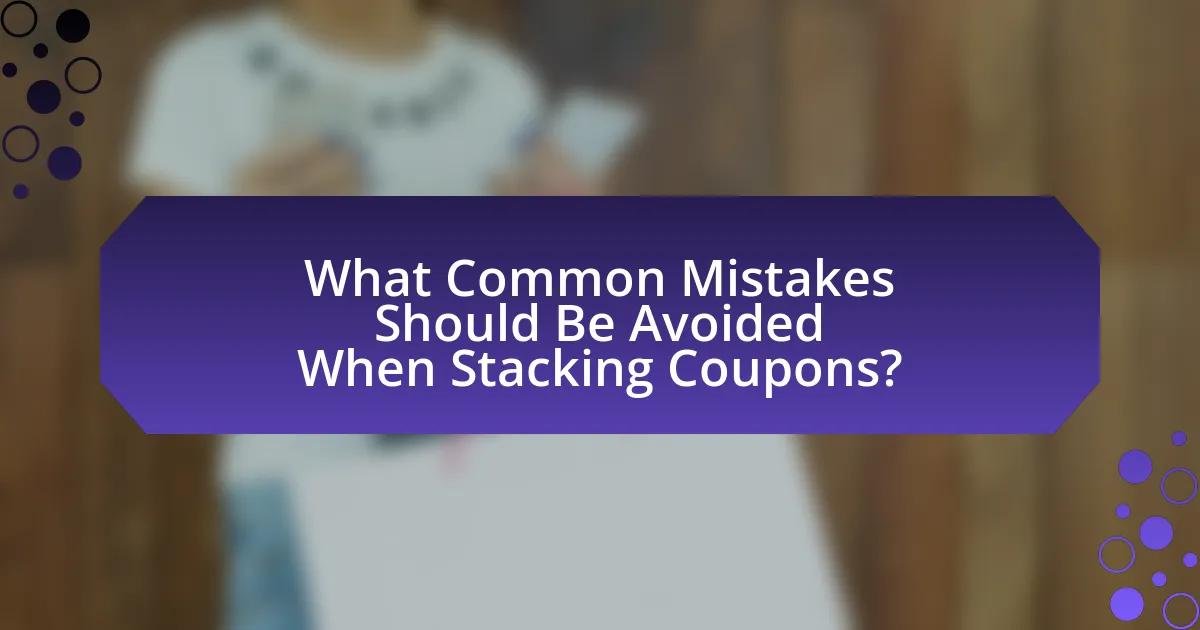The article focuses on the practice of stacking coupons to achieve greater savings during shopping. It outlines the various types of coupons that can be combined, such as manufacturer and store coupons, and discusses the rules and strategies for effective coupon stacking. Key benefits include potential savings of 10% to 50% on total purchases, enhanced consumer satisfaction, and the psychological advantages of using coupons. Additionally, the article provides practical tips for finding, organizing, and timing coupon usage, as well as common mistakes to avoid, ensuring consumers can maximize their savings effectively.

What are the Basics of Stacking Coupons for Greater Savings?
Stacking coupons involves using multiple discounts on a single purchase to maximize savings. To effectively stack coupons, shoppers should first understand the types of coupons available, such as manufacturer coupons, store coupons, and digital coupons. Each type can often be combined, depending on the store’s policy. For instance, many retailers allow customers to use one manufacturer coupon and one store coupon on the same item. Additionally, shoppers should check for sales or promotions that can further enhance their savings when combined with coupons. Research indicates that strategic coupon stacking can lead to savings of 50% or more on total purchases, making it a valuable technique for budget-conscious consumers.
How does stacking coupons work in practice?
Stacking coupons allows consumers to combine multiple discounts on a single purchase, maximizing savings. In practice, this typically involves using a manufacturer’s coupon alongside a store coupon for the same item, or applying a coupon on top of a sale price. For example, if a product is on sale for $10 and a store offers a $2 off coupon while a manufacturer provides an additional $1 off coupon, the consumer can purchase the item for $7. This method is widely utilized in retail environments where both types of coupons are accepted, and many stores explicitly allow stacking as a promotional strategy to attract customers.
What types of coupons can be stacked together?
Stackable coupons typically include manufacturer coupons, store coupons, and loyalty program discounts. Manufacturer coupons can be used alongside store coupons, allowing customers to maximize savings on a single purchase. Additionally, loyalty program discounts can often be combined with both types of coupons, further enhancing the total discount received. This stacking strategy is supported by many retailers’ policies, which explicitly allow the use of multiple coupon types on a single transaction to encourage customer loyalty and increase sales.
What are the common rules for stacking coupons?
Common rules for stacking coupons include using one manufacturer coupon and one store coupon on the same item, ensuring that the coupons do not have conflicting terms, and adhering to the expiration dates of each coupon. Additionally, some stores may have specific policies regarding stacking, such as limiting the number of coupons per transaction or requiring that one coupon be a digital version. These rules help maximize savings while ensuring compliance with store policies and manufacturer guidelines.
Why is stacking coupons beneficial for consumers?
Stacking coupons is beneficial for consumers because it allows them to maximize their savings on purchases. By combining multiple coupons, such as manufacturer coupons with store coupons, consumers can significantly reduce the total cost of their shopping. For instance, a study by the Coupon Information Corporation found that consumers can save an average of 20% more when stacking coupons compared to using a single coupon. This strategy not only enhances the value of discounts but also encourages consumers to buy more items at a lower overall price, making it a practical approach to budgeting and spending.
How much can consumers save by stacking coupons?
Consumers can save between 10% to 50% on their total purchases by stacking coupons. This range depends on the type of coupons used, the store policies, and the total amount of the purchase. For instance, a study by the Coupon Information Corporation found that consumers who effectively stack manufacturer and store coupons can achieve significant savings, often maximizing discounts on sale items. Additionally, some retailers allow the combination of digital and paper coupons, further enhancing potential savings.
What are the psychological benefits of using coupons?
Using coupons provides several psychological benefits, including enhanced feelings of control, satisfaction, and financial empowerment. When individuals use coupons, they often experience a sense of accomplishment and mastery over their spending, which can lead to increased self-esteem. Research indicates that consumers who engage in couponing report higher levels of happiness and satisfaction due to the perceived savings, reinforcing positive shopping behaviors. Additionally, the act of finding and using coupons can stimulate dopamine release in the brain, creating a rewarding experience that encourages continued coupon use.

What Strategies Can Be Used for Effective Coupon Stacking?
Effective coupon stacking strategies include understanding store policies, combining manufacturer and store coupons, and timing purchases with sales events. Store policies often dictate how many coupons can be used in a single transaction, so knowing these rules allows shoppers to maximize savings. For instance, many retailers permit the use of both a manufacturer coupon and a store coupon on the same item, effectively doubling the discount. Additionally, timing purchases during sales events, such as holiday sales or clearance events, can further enhance savings when combined with coupons. Research indicates that consumers can save up to 50% or more on their grocery bills by strategically stacking coupons with sales (Source: CouponCabin, 2021).
How can consumers find the best coupons to stack?
Consumers can find the best coupons to stack by utilizing multiple resources such as coupon websites, mobile apps, and store loyalty programs. Websites like RetailMeNot and Coupons.com aggregate various coupons, while apps like Ibotta and Rakuten offer cashback opportunities that can be combined with manufacturer coupons. Additionally, signing up for store loyalty programs often provides exclusive coupons and promotions that can enhance stacking potential. Research indicates that consumers who actively use these resources can save an average of 20-30% on their purchases, demonstrating the effectiveness of strategic coupon stacking.
What are the best websites and apps for coupon hunting?
The best websites and apps for coupon hunting include RetailMeNot, Honey, and Rakuten. RetailMeNot offers a vast database of coupons and cashback offers from various retailers, making it easy for users to find discounts. Honey, a browser extension and mobile app, automatically applies coupon codes at checkout and provides price tracking for items. Rakuten allows users to earn cashback on purchases made through its platform, in addition to offering coupon codes. These platforms are widely recognized for their effectiveness in helping consumers save money while shopping.
How can consumers stay organized with their coupons?
Consumers can stay organized with their coupons by using a systematic approach that includes categorizing, storing, and regularly updating their coupons. Organizing coupons into categories such as groceries, household items, and personal care products helps consumers quickly locate relevant coupons when shopping. Utilizing a binder with clear plastic sleeves or a digital app designed for coupon management allows for easy access and tracking of expiration dates. Research indicates that consumers who maintain an organized coupon system can save an average of 20% on their grocery bills, demonstrating the effectiveness of this method in maximizing savings.
What timing considerations should be made when stacking coupons?
When stacking coupons, timing considerations include the expiration dates of each coupon and the timing of sales events. Expiration dates dictate how long a coupon remains valid, and using them before they expire maximizes savings. Additionally, aligning coupon use with sales events can enhance discounts; for example, using coupons during a store-wide sale can lead to greater overall savings. Research indicates that consumers who strategically time their coupon usage during promotional periods can save up to 30% more than those who do not.
How do sales cycles affect coupon stacking opportunities?
Sales cycles significantly influence coupon stacking opportunities by determining when products are discounted and when coupons can be applied. During promotional periods, such as seasonal sales or clearance events, retailers often allow customers to use multiple coupons on already discounted items, maximizing savings. For instance, a study by the National Retail Federation indicates that 68% of retailers offer additional discounts during sales events, which can include coupon stacking. This practice enables consumers to combine manufacturer coupons with store promotions, enhancing overall savings potential.
What is the best time of year for stacking coupons?
The best time of year for stacking coupons is during major sales events, particularly around Black Friday, Cyber Monday, and the back-to-school season. These periods often feature significant discounts and promotions, allowing consumers to combine manufacturer coupons with store sales for maximum savings. For example, retailers frequently offer additional discounts during these events, which can be stacked with existing coupons, leading to substantial overall savings.

What Common Mistakes Should Be Avoided When Stacking Coupons?
Common mistakes to avoid when stacking coupons include not checking the store’s coupon policy, which can lead to rejected coupons. Many retailers have specific rules about which coupons can be combined, and failing to understand these can result in lost savings. Additionally, shoppers often overlook expiration dates on coupons, leading to the use of invalid coupons at checkout. Another frequent error is stacking coupons on items that are already on sale, which may not be permitted by some stores, thus negating the intended savings. Lastly, failing to organize and track coupons can lead to missed opportunities, as shoppers may forget which coupons they have or when they expire.
What are the pitfalls of stacking coupons?
Stacking coupons can lead to several pitfalls, including confusion over terms and conditions, potential for reduced savings, and expiration issues. Confusion arises when multiple coupons have different restrictions, making it difficult for consumers to understand which coupons can be combined. This complexity can result in reduced savings if the consumer inadvertently uses a less advantageous coupon or fails to apply a more beneficial one. Additionally, many coupons have expiration dates, and managing multiple coupons increases the risk of missing these deadlines, leading to wasted opportunities for savings.
How can consumers avoid expired or invalid coupons?
Consumers can avoid expired or invalid coupons by regularly checking the expiration dates and terms of use before attempting to redeem them. Many retailers provide clear expiration dates on their coupons, and consumers should always verify these details to ensure validity. Additionally, subscribing to newsletters or following brands on social media can provide updates on current promotions and valid coupons, reducing the likelihood of using outdated offers.
What are the consequences of not reading coupon terms and conditions?
Not reading coupon terms and conditions can lead to unexpected financial losses and missed savings opportunities. Consumers may inadvertently use coupons that are expired, restricted to specific products, or have minimum purchase requirements, resulting in the inability to redeem the coupon as intended. For example, a study by the National Retail Federation found that 30% of consumers reported issues with coupon redemption due to not understanding the terms. Additionally, failing to read these conditions can lead to frustration at checkout and potential embarrassment, as well as the loss of trust in promotional offers from retailers.
How can consumers troubleshoot issues with coupon stacking?
Consumers can troubleshoot issues with coupon stacking by first reviewing the terms and conditions of each coupon to ensure compatibility. Many retailers have specific policies regarding which coupons can be combined, and understanding these rules can prevent confusion. Additionally, consumers should check the expiration dates and any restrictions on the coupons being used, as expired or restricted coupons may lead to issues at checkout. If problems persist, contacting customer service for clarification can provide guidance on how to effectively stack coupons. Retailers often have dedicated support for coupon-related inquiries, which can help resolve any misunderstandings.
What should consumers do if their coupons don’t work at checkout?
Consumers should first check the expiration date and terms of the coupon to ensure it is valid. If the coupon is still valid but does not work at checkout, consumers should inform the cashier or customer service representative about the issue. Retailers often have policies in place to address such situations, and they may be able to manually apply the discount or provide an alternative solution. According to a survey by the Coupon Information Corporation, approximately 90% of retailers are willing to assist customers with coupon-related issues when approached politely.
How can consumers resolve disputes with retailers over coupon policies?
Consumers can resolve disputes with retailers over coupon policies by first reviewing the retailer’s coupon policy, which is typically available on their website or at the store. Understanding the specific terms and conditions associated with the coupons can clarify any misunderstandings. If a dispute arises, consumers should gather relevant documentation, such as receipts and copies of the coupons in question, to support their case.
Next, consumers should communicate directly with the retailer’s customer service, either in person or through official channels like email or phone. Presenting the facts clearly and calmly can often lead to a resolution. If the issue remains unresolved, consumers may escalate the matter by contacting the corporate office of the retailer or filing a complaint with consumer protection agencies, which can provide additional support and guidance.
Retailers often aim to maintain customer satisfaction, so a well-documented and respectful approach can significantly increase the chances of a favorable outcome.
What are the Best Practices for Successful Coupon Stacking?
The best practices for successful coupon stacking include understanding store policies, combining manufacturer and store coupons, and timing purchases strategically. Store policies vary, so knowing whether a store allows stacking can maximize savings. Combining manufacturer coupons with store coupons often leads to greater discounts on a single item. Additionally, timing purchases during sales events or clearance can further enhance savings, as many stores allow coupon stacking during these promotions. For instance, a study by the National Retail Federation indicates that consumers can save an average of 20% more when effectively stacking coupons during sales.
How can consumers maximize their savings through strategic planning?
Consumers can maximize their savings through strategic planning by effectively stacking coupons and utilizing promotional offers. By combining manufacturer coupons, store coupons, and cashback deals, consumers can significantly reduce their overall expenses. For instance, a study by the Coupon Information Corporation found that consumers who regularly stack coupons can save an average of 20-30% on their grocery bills. Additionally, planning purchases around sales events and using loyalty programs can further enhance savings, as many retailers offer exclusive discounts to members. This strategic approach not only maximizes savings but also encourages smarter shopping habits.
What tips can help consumers become more effective coupon stackers?
To become more effective coupon stackers, consumers should first understand the store policies regarding coupon stacking, as some retailers allow combining manufacturer and store coupons for greater savings. Additionally, consumers should organize their coupons by category or expiration date to easily access them during shopping. Research indicates that using digital coupon apps can enhance savings, as these platforms often provide exclusive offers and allow for easy tracking of deals. Furthermore, consumers should stay informed about sales cycles and seasonal promotions, which can maximize the effectiveness of stacked coupons.



